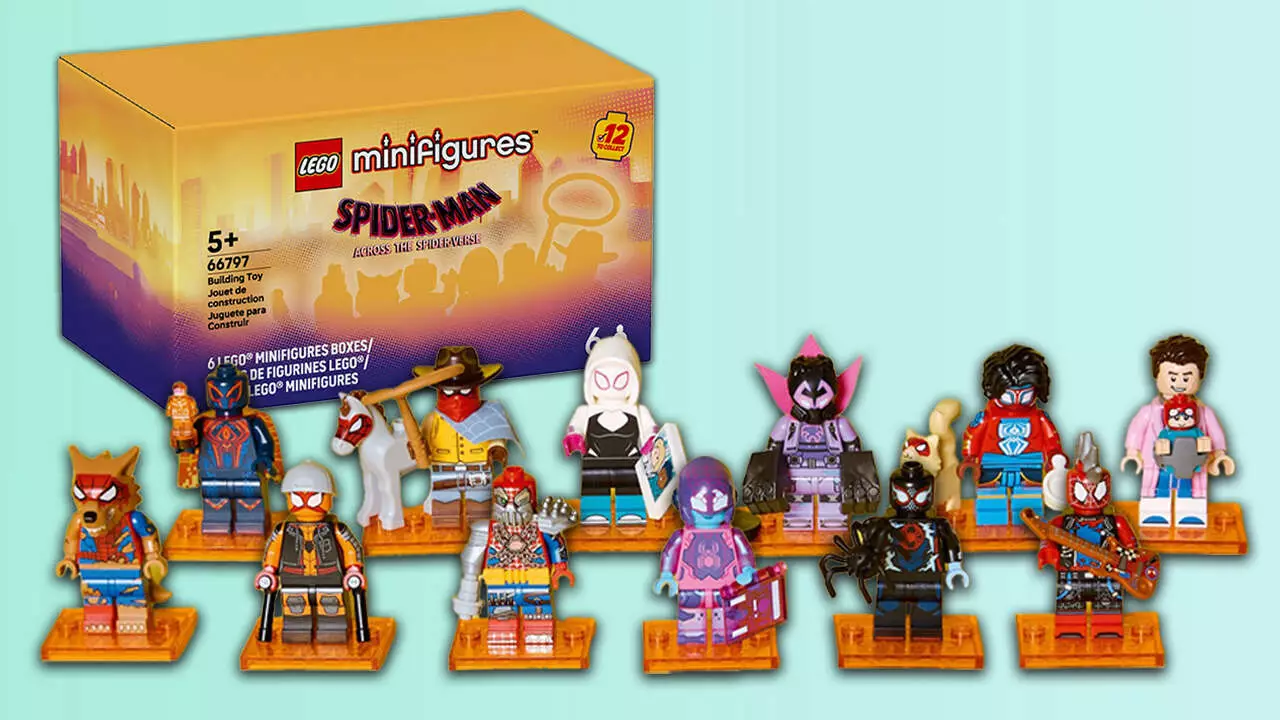Lego is once again redefining the universe of collectibles with its latest release—the Spider-Man: Across the Spider-Verse minifigure series. Set to hit shelves on September 1, this collection signifies more than just a casual addition to Lego’s extensive lineup; it embodies a strategic push towards tapping into one of Marvel’s most vibrant and eclectic universes. Unlike traditional minifigure series that often feature familiar faces, this series boldly ventures into the multiverse, embracing its zaniness and unpredictability. With 12 uniquely characterized figures, this set offers collectors an exciting chance to own a slice of cinematic and comic book history, but it also underscores a shifting paradigm in Lego’s approach to limited-edition, highly desirable collectibles.
What makes this release particularly compelling is Lego’s decision to sell these figures both individually in mystery bags and in curated six-packs. The mystery bag format injects a level of thrill akin to a gambling experience—serially appealing to collectors who thrive on the chase, but also prone to frustration with duplicates. The six-pack bundles, meanwhile, serve as a more strategic choice for enthusiasts aiming to complete their collections efficiently. This dual distribution method reflects Lego’s nuanced understanding of its audience, catering both to casual fans and die-hard collectors willing to invest more for the promise of diversity and completeness.
A Multiverse of Characters and Play Possibilities
Stepping beyond the traditional, Lego’s “Across the Spider-Verse” series brings a myriad of characters that span the multiverse—each with distinct quirks and collectibles potential. From the familiar Miles Morales to the bizarre Werewolf Spider-Man and Sun-Spider, the series celebrates the franchise’s creativity and unpredictability. The inclusion of characters like Spider-Punk with his electric guitar or Patrick O’Hara paired with a horse adds a playful depth, emphasizing Lego’s commitment to capturing both personality and narrative richness. It’s not just about minifigures; it’s about bringing to life a multidimensional universe, encouraging imaginative play and storytelling.
The accessories accompanying the figures are carefully curated to enhance this experience. For instance, Spider-Punk’s guitar, Web-slinger’s horse, and Pavitr Prabhakar’s (Spider-Man India) tiny, adorable cat figure are well-chosen additions that elevate each minifigure beyond mere display pieces. Of particular note is Peter B. Parker’s miniaturized baby carrier, which contains a tiny Mayday—an incredible detail reflecting Lego’s dedication to narrative authenticity. These accessories introduce layers of storytelling, inviting collectors to recreate scenes from the film or invent entirely new adventures. Such nuanced details demonstrate Lego’s understanding that modern collectors seek more than just figures—they want immersive experiences.
Challenges and Opportunities in Building the Set
While the prospect of acquiring all 12 figures is enticing, the reality is that randomness makes complete collection a game of chance. Especially if limited to just a few mystery boxes, collectors might find themselves facing the disappointment of duplicates, prolonging their quest for every character. This reality prompts a broader debate on the effectiveness of “blind bag” marketing in the collectible space. Despite this, Lego cleverly provides options—six-packs for $30 ensure a better chance at diversifying your haul, making repeated purchases a worthwhile investment for dedicated fans.
Lego’s history of rapid discontinuation of sets and series plays a significant part here. The Dungeon & Dragons minifigures, once popular, are now rare and highly coveted after their retirement. This tendency underscores a strategic move—by introducing limited runs that are only available for a short period, Lego fuels desire and scarcity, which, in turn, elevates the perceived value of these collectibles. This approach fosters a sense of urgency among collectors and fans, urging them to act quickly or risk missing out on creating their ultimate Spider-Verse tableau.
The Broader Collector’s Landscape and Future Outlook
The significance of this release extends beyond its immediate figures. Lego has historically been a pioneer in blending construction sets with collectible art. Its larger, articulated action figures—like the Spider-Man Mech—continue this tradition while appealing to consumers who want display-worthy, highly detailed characters. The recent restocking of retired sets such as the Spider-Man Construction Figures suggests a thriving secondary market, proving Lego’s ability to attract both new and seasoned aficionados.
Moreover, the integration of cross-franchise bundles—such as exclusive Star Wars and Minecraft sets—illustrates Lego’s evolving strategy to keep fans engaged across multiple universes. The $45 Star Wars 3-in-1 Adventure Gift Set and the Minecraft World Explorer bundle offer lifelong fans not just mini figures, but immersive building experiences that can be treasured for years. These diverse offerings reinforce Lego’s position as a cultural omnipresence—where collecting isn’t just about individual figures but about creating a personalized universe that spans genres and fandoms.
In this landscape, the Spider-Man: Across the Spider-Verse minifigure collection isn’t merely a new product—it’s a statement. Lego is cementing its role at the intersection of pop culture, nostalgia, and storytelling. For collectors and lovers of all things Spider-Man, this series symbolizes more than figures—it’s a gateway to building, imagining, and owning a piece of the multiverse in ways that are as bold as the characters themselves.

